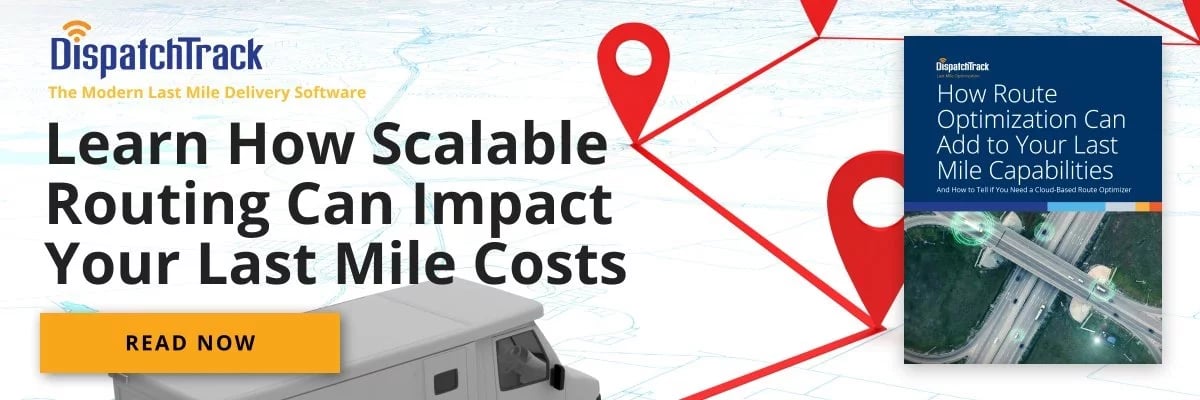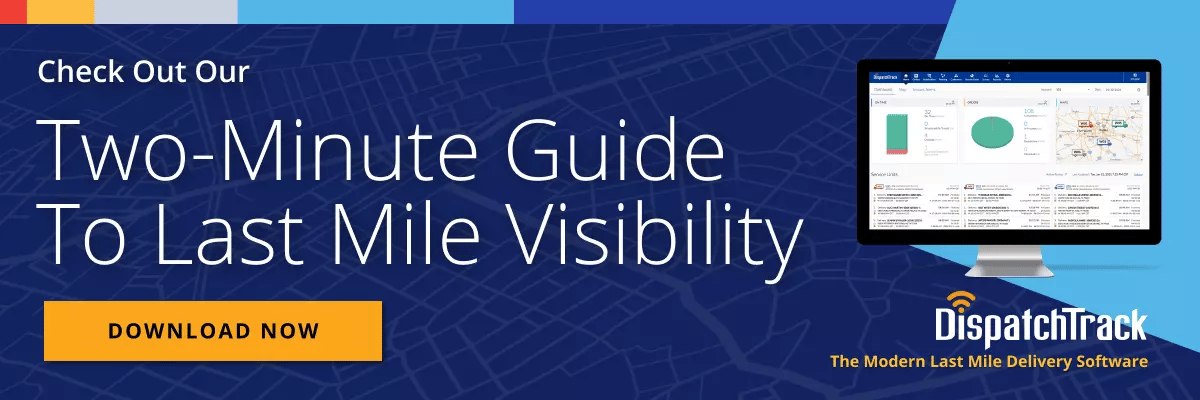The following is Part 2 in a series of posts about DispatchTrack’s point of view on the trends that will drive the logistics and logistics technology markets in 2022 and beyond. This week, we’ll be discussing the increasing emphasis on speed over price in the current logistics climate. You can check out Part 1, or you may also be interested in DispatchTrack CEO and co-founder Satish Natarajan’s Logistics Technology Wishlist for 2022.
If you had to describe the modern consumer, “patient” is probably not a word that would come to mind. It’s probably not a word you’d use to describe the modern fleet manager or supply chain executive either.
.webp?width=1200&name=last%20mile%20logistics%20trends%202%20(1).webp)
This in and of itself isn’t exactly a trend—but with supply chains around the world evolving every day, the ability to actually meet people’s last mile logistics demands quickly is becoming more and more feasible. More than that, it’s increasingly become the norm—or at the least the baseline expectations. That’s why in 2022, we expect businesses and the folks who patronize them to keep putting more and more focus on speed.
Why Speed Is More Important in Logistics Than Ever
Let’s look at this from the customer’s side first: You’ve gotten used to Amazon’s fulfillment times, and you don’t necessarily care about how they make it possible. When you’ve picked out the perfect couch online—or even in a brick and mortar showroom—you don’t want to wait around for it.
If you’re shopping online and you see a 2-week shipping turnaround with no option for choosing your preferred, you’re not going to care about the complexities of big and bulky delivery. You’re not going to be interested in any of the reasons why it’s always been slow and expensive to ship furniture—you’re going to look for a better offer. You might even be willing to pay a little bit extra on the product itself to get a quicker turnaround and a better experience.
And the view from the retailer or distributor’s side actually isn’t too different. The faster you can move product around, the more business you can win. Not only do you potentially provide a better customer experience at that point, you’re also shortening your cycle times, which means you can handle higher order volumes and ultimately do more business.
The emphasis on speed in logistics is really a win-win, which is exactly why we think it’s going to be a defining feature of the supply chain in general and last mile logistics in particular in the next couple of years.
The question is: how do last mile operators capitalize on that trend?
How to Speed Up Your Last Mile Deliveries
Deliveries being defined by an emphasis on speed is going to be contingent on a few things: smarter routing, better visibility, and increased automation throughout the planning and execution of a host of different supply chain processes. If you’re trying to cycle orders through your supply chain faster than you have in the past, there’s going to be pressure on every touchpoint on the chain—particularly the final mile, since that has historically been the least efficient part of the logistics process.
Let’s dig into the “how” a little bit more.
Smarter Routing
Routing as a process impact speed in two huge ways:
- Creating capacity: The efficiency of your routes determines how many orders you can fulfill in a given day. When you have routing capabilities that enable you to complete more stops per route, you can cycle through orders that much faster and avoid the kinds of delays that push buyers towards your competitors.
- Planning speed: You can’t execute on plans that don’t exist. That means that the speed at which you plan your last mile routes has a direct impact on how quickly you can get the product to the customer’s door or over their threshold or installed. When you can route thousands of stops in seconds, you can obviously offer much faster shipping turnarounds than you could if your routing calculations always had to be run overnight.
Right off the bat, if you can optimize your routes via a last mile solution that produces efficient sequences of stops in a matter of seconds, you delight your customers more quickly and move product.

Better Visibility
Though dynamic routing capabilities can certainly help you deal with last minute requests on the fly, route optimization still falls more into the planning category than the execution category. For speedy execution, what you need is real-time visibility throughout—and beyond—the last mile. Here, there are two important questions to discuss:
- Why is visibility so crucial? When you know where each truck, driver, and item is in the world at any given time, you can execute plans more quickly and spot exceptions more easily. When that visibility extends to the status of each order as it’s being delivered, you gain the ability to make quick decisions that keep deliveries moving even amid complexity. If you lack that level of visibility, it’s impossible to keep plans on track, which will ultimately slow you down.
- What does visibility actually look like? The last mile tends to entail a total black box, or information overload. What visibility means in practice is getting to the right information, quickly. You shouldn’t have to hunt through multiple screens to see the status of a particular order, and you should get alerts for predefined events (i.e. late or incomplete deliveries). Naturally, this also means being able to see where in the world your trucks and drivers are at any given moment.
Why does this matter? Again, it’s all about speed—i.e. how long it takes you to find out that something’s going wrong and find a solution. When it comes to logistics, you have to expect the unexpected. Last mile visibility is how you position yourself to bridge the gap between planning and execution.
Increased Automation
We already talked a little bit about how automated route optimization can speed up your planning processes and help you move more product. But that’s not the only area where automation can help you get more out of your capacity. Increasingly, we expect to see supply chains introducing automation into a number of different areas:
- Customer communication: When you can automatically confirm delivery appointments with customers and give them a heads up when the delivery is on its way, you can decrease failed deliveries—bringing down your average time to deliver significantly.
- Back office processes: This might include anything from calculating driver settlements to invoicing clients. While this won’t always have a direct impact on how quickly you get your couches, refrigerators, or pallets of wine out the door, it does give you the chance to increase your overall efficiency.
- Order tracking: To offer automated order tracking to customers, you need to first achieve the level of visibility we discussed above and find a way to make it accessible to your customers. If you can do that, the payoff can be huge—when folks can check in the delivery status and ETA of their order at their leisure, there’s much less need to call in and inquire. This takes a lot of pressure off your staff, leaving them with more time to spend on finding new efficiencies and speeding up your logistics processes even further.
In 2022, we expect speed to be a more important consideration than price for most businesses. New techniques and technologies will be adopted with more emphasis on performance than on cost—because right now it’s worth it to spend more to get deliveries out that much faster. Even so, investments in a faster supply chain are going to be for the long haul. If you lay the groundwork for optimization now, you’ll be able to stay competitive even as the market continues to evolve.
